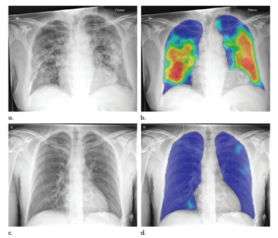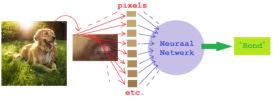21st Century Doctors
Algorithms against Covid-19
On May the 8th, 2020, a study was published from Radboud University on the development of a digital system that can identify Covid-19 by viewing X-rays of patients’ lungs. In addition to a diagnosis from a lab, corona is also visible in X-ray scans of the lungs of patients. In many of the cases this system was as good at making a diagnosis as radiologists themselves. It is also faster and cheaper. But you could also question the use of algorithms in healthcare. What is such a digital system, and why should we trust it?
Image recognition
The systems used in the investigation of Covid-19 in long scans use image recognition, which is a subtopic of Artificial Intelligence (AI). Using a lot of examples, they have learned how to distinguish pictures from each other. This is done using a neural network (see figure 1). It learns in a similar way to our own brains, by forming a network of (electronic) neurons. It improves itself every time it sees an image by adjusting this network. If the system has seen a lot of images, it will hopefully evaluate a new image properly.
Systems developed with the help of Artificial Intelligence have been used in the radiology department of certain hospitals for four years, says radiologist Dr Firdaus Mohamed Hoesein of the University Medical Center Utrecht. “These systems help us to make a diagnosis, but they don’t do that themselves yet. Much more research is needed for that. ”

Image 1. Image recognition starts with an image, in this case of a dog. The system then examines all the pixels, and uses this information to improve its neural network and ultimately gives the picture the label “dog”.
Object recognition in the hospital
Dutch hospitals are still a bit reluctant to apply Artificial Intelligence. It is a very new technique. Only a few years ago computers have developed far enough to be able to apply artificial intelligence. Much research is still needed on the success of these systems in hospitals and in individual patients. Increasingly, however, research is being conducted into the use of image recognition within healthcare in the Netherlands.
image recognition is already regularly used in America. There they use this on a large scale to detect breast cancer. In America, people often have to pay for medical costs themselves. Using digital systems is simply cheaper. In the Netherlands, this breast examination is paid for by the government and there are sufficient specialists available. The same goes for the diagnosis of Covid-19, says Dr. Mohamed Hoesein. “It is not necessary. We have the manpower and money to make a diagnosis ourselves as radiologists. Until more is known about the success of these digital systems. ” In addition, a lot of information still needs to be collected and processed in order to draw better conclusions.
Covid-19 in lung scans
A lot of information is needed to train a system. This often amounts to thousands of images. In Figure 2 you can see how the system that can predict Covid-19 detects the affected lungs. Because Covid-19 is just a recent disease, not that many images were available yet. Only 500 images were used to train the system. These images also come from one hospital. This can cause the system to work less well with images from other hospitals, because there is a certain bias in the system. If more different images are taught to the system, the system will likely be less biased and make fewer mistakes.

Picture 2: Picture a & b are of a 74 year old corona patient. (a) represents the X-ray of the man’s lungs, (b) represents the X-ray as perceived by the system. Pictures c & d are of a 30 year old man who is healthy. (c) represents the X-ray of the male’s lungs, (d) represents the X-ray as perceived by the system. The system knew with a 99.8 percent certainty in the top patient that he was dealing with a victim of corona.
Do we trust algorithms?
Can an algorithm like this help us relieve the current pressure on healthcare? Dr. Mohamed Hoesein says no. “Diagnosis is not the main concern at the moment. The biggest concern is that patients need intensive care and that the hospitals are filling up. ” He also elaborates on the use of the system in countries where making a diagnosis is a problem. “Developing countries could benefit from such a system. If fewer specialists are available, algorithms can take over this task. ”
“AI is the future,” says Dr. Mohamed Hoesein. And he is not afraid that a computer will take over his job. “Ultimately, doctors will all become experts in the use and consequences of AI in healthcare. Until then, there is still plenty to research about the applications of AI, for example in my current research about investigating the long-term effects of Corona. ” Artificial Intelligence is still very evolving and mysterious. But with a little confidence, it’s also hugely promising.
Learn more:
AI can help diagnose COVID-19 on X-rays (Dutch article), Stephan van Duin, June 17, 2020, https://www.radboudumc.nl/nieuws/2020/ai-kan-helpen-covid19-te-diagnosticeren-op-rontgenfotos
Slightly more complicated, a podcast about doctor and algorithm (Dutch podcast): https://open.spotify.com/episode/4QPBmqBUkZZZXw6WMGGFrX?si=cmRNBFVcST6r5QF7_2yY2g
About Dr. Mohamed Hoesein’s most recent research: https://www.uu.nl/en/news/research-into-the-development-of-lung-damage-and-chronic-complaints-after-covid-19
In-depth informative video on computer vision, CrashCourse 2017 https://www.youtube.com/watch?v=-4E2-0sxVUM
How computers keep getting better at recognizing images (Dutch article), Roel van der Heijden, 29 June 2017, found at: https://www.nemokennislink.nl/publicaties/hoe-computers-steeds-beter-worden-in-het-herkennen-van-beelden/?search_page=true
Other source:
Murphy, K., Smits, H., Knoops, A. J., Korst, M. B., Samson, T., Scholten, E. T., … & Melendez, J. (2020). COVID-19 on Chest Radiographs: A Multireader Evaluation of an Artificial Intelligence System. Radiology, 296 (3), E166. https://pubs.rsna.org/doi/10.1148/radiol.2020201874

